A video simulation abruptly airs on the news. The rendered video shows what the city centre of Skopje will look like in 2014. Peopleless landscapes with monuments spinning around their axis. The grandiose sound accompanying the visual reinforces the experience of the simulation: a staged micro-macro world impersonating antiquity.
Will such reconstruction take place!? Stills from the video and questions overflow the newspapers. Some citizens find comfort in believing that the state does not have enough resources to materialise those renders quickly.
Others gather forces to oppose the remodelling.
Despite the resistance, metal partitions take over the square, the river’s left bank, and spread into different areas of the centre. Drilling sounds mark the start of the building process.
Façade, override, façade
overrides
layer after layer,
today comes before yesterday,
perpetually overruled by tomorrow
each layer, emphasises a difference,
differences rendered visible,
layer upon layer,
piling layers, peeling layers
overlaid,
superimposed,
exclusion,
glitch,
Will such reconstruction take place!? Stills from the video and questions overflow the newspapers. Some citizens find comfort in believing that the state does not have enough resources to materialise those renders quickly.
Others gather forces to oppose the remodelling.
Despite the resistance, metal partitions take over the square, the river’s left bank, and spread into different areas of the centre. Drilling sounds mark the start of the building process.
Façade, override, façade
overrides
layer after layer,
today comes before yesterday,
perpetually overruled by tomorrow
each layer, emphasises a difference,
differences rendered visible,
layer upon layer,
piling layers, peeling layers
overlaid,
superimposed,
exclusion,
glitch,
Façade_Override_Façade, performative lecture, puntWG, 2021, Amsterdam.
Documentation by Baha Görkem Yalım
Documentation by Baha Görkem Yalım
# Scene 1
> 41.99706951740767, 21.432223365374753
Passing by our favourite tree,
a strange feeling of discontent merged with bitterness and fused with disbelief.
the heads bearly reaching one-fourth of its height
my foot slips on a fallen leaf
our woollen coats brush by each other
new scares covering our exposed knees,
My foot slips on a loose tile
I stretch out my hand,
counting the traces of bruises on my leg,
Muscle memory is the act of writing a specific motor task into memory through repetition.
I anticipate my hand touching a surface of a willow tree.
Instead, I fall forward with all my weight until somehow I regain my balance.
A passerby asks me if I am all right.
I stumble to find the answer.
I was all right, yes.
No, not really.
How does one exercise publicness in times of cut trees? <
I'm facing away from the television. My grandparents are watching the news and in the background I can hear a man's voice arguing the importance of the city's redesign. Years have gone since then, and although I don't remember the person's name, I recall part of his words: “The remodelling gave Skopje a chance, for the first time since the country's independence, to coin its own identity.” Oddly, those kinds of thoughts draw people in. Perhaps it’s easier to balance the weight on hardened asphalt. It’s much more difficult to let yourself be part of moving grounds, to move with the fluid nature of the city, which evolves gradually over and through time, drawing from and with the experiences. One cannot force something which is inevitably in flux. You can try to contain water in a porous vessel, but the liquid will always find a way out.
> I follow the developments behind the screen, 2.199km away from Skopje. I read the discussions, and browse through images from the construction of new buildings, façades overriding façades, and monuments sprouting as twelve parks are turned into sites for construction.<
>>In a series of audio-files, phone-calls between, then high ranking government officials, that are released to the public, two voices can be heard discussing the planning process of the series of buildings and their facades. Is it ‘baroque or classicism’? In the areas where there is too much ‘classicism’, one of the voices says that ‘baroque’ façades’ should also be included. In trying to clarify what is what, the voice says: if it has columns than it is ‘clacissism’ and if you want ‘baroque’ search for references in European cities,... there is ‘baroque’ everywhere.<<
The government-initiated project, known to the public as “Skopje 2014,” stirred the citizens of Skopje and created an international discussion regarding public space and architectural heritage. Architectural professionals define “Skopje 2014” as antiquization: a constructed narrative produced by fabricated and aestheticised adaptation of the history of a nation, as it aimed to erase modernist architecture. Until 2016, 136 new structures were built in Skopje’s city centre, surpassing the initially announced construction. New buildings, replicas of buildings destroyed during the 1963 earthquake, monuments, bridges, and fountains took over open spaces such as lawns and promenades. Destruction of the urban commons. Growth of the common debt. The ‘façading’ of existing buildings, considered a relevant modernist heritage, caused anger among architectural professionals. The execution of these new façades was without the permission of the architects whose work is now resting underneath polystyrene façades.

Images from Façade_Override_Façade, 2021, exhibition bound in book form, limited edition of 30 copies.
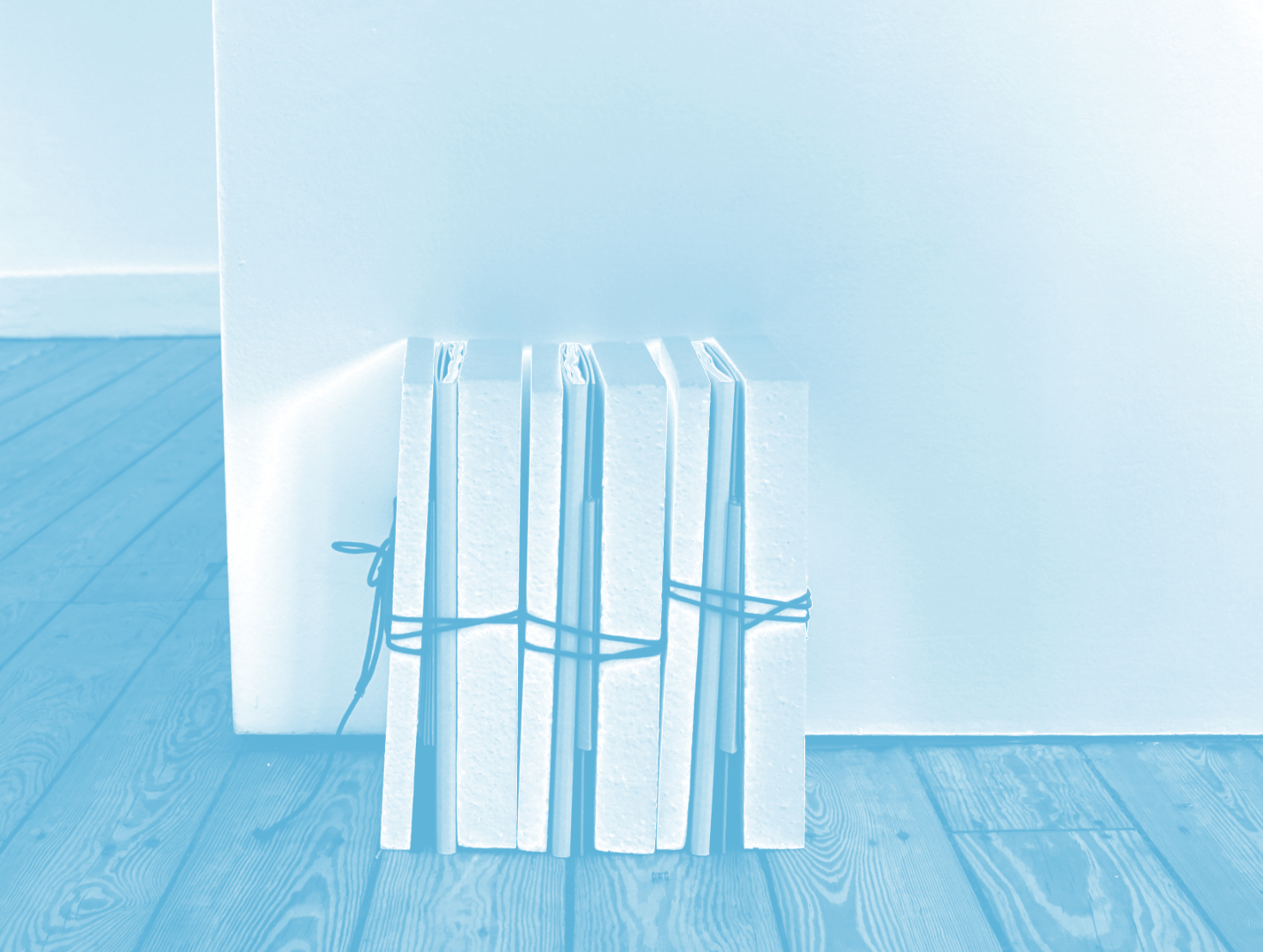
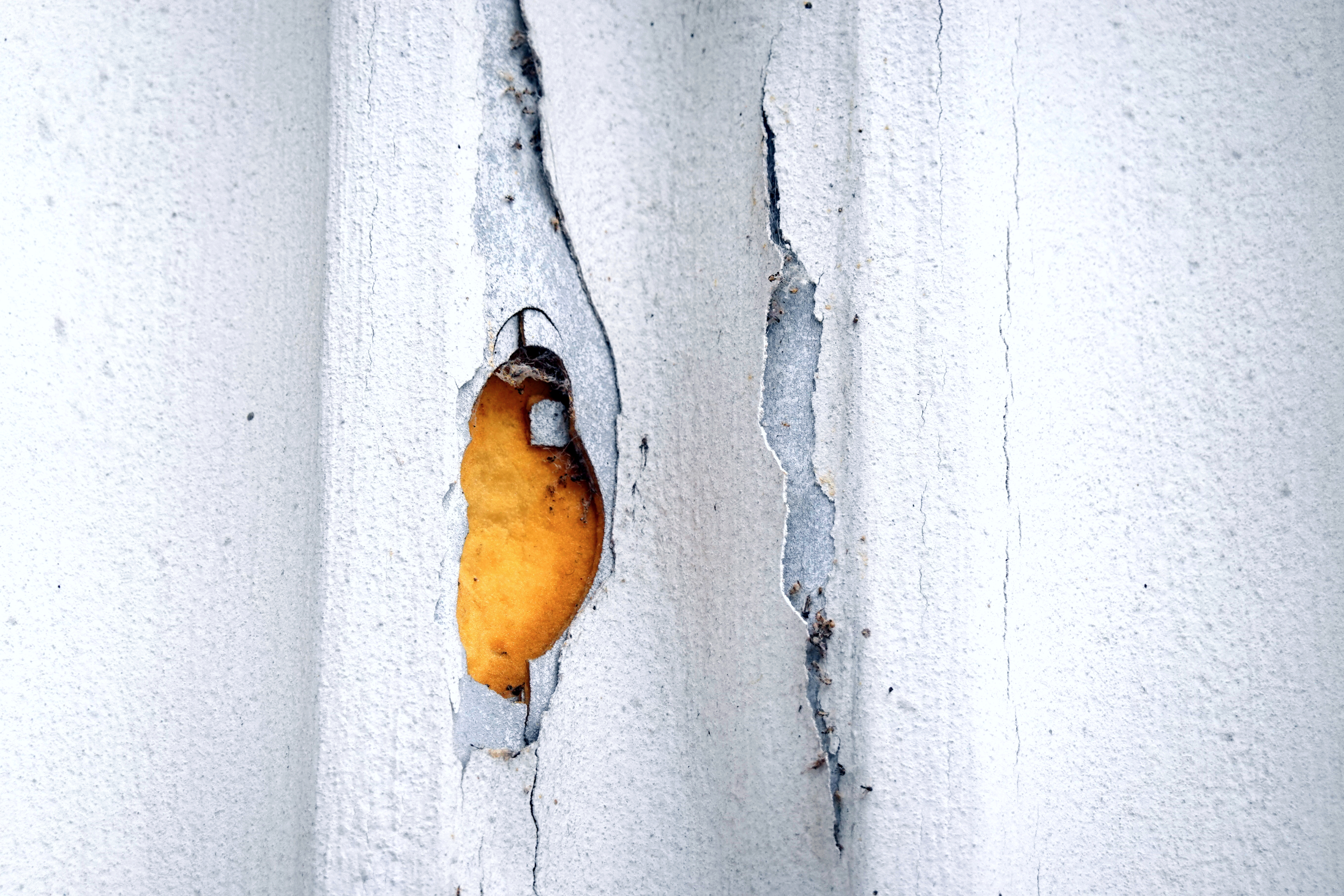
# Scene 2
>41.99861634715371, 21.432071820598438
With confidence I rest my elbow on a nearby wall to support my hand as I try to concentrate on a peculiar detail on a column. For a moment it seems like a good idea, until I realise that my elbow is sinking into the wall. Different materials emerge from beneath the first coating, and suddenly the notion of a façade gains a different meaning. The minor aperture opens up a possibility for buried layers to become visible, an access point from which the boundary that a façade creates starts slowly to break down. When contingent and disruptive processes invade a façade, when materials clash and questions about restoration and repair begin to be asked, we understand that not even architectural structures should be considered ‘longue durée’.
Excerpt from Façade_Override_Façade, 2021, exhibition bound in book form.
Looking at my own skin, slightly burned from the strong sun, I think of words inscribed on parchment. For a long time texts were registered one on top of the other, layer over layer. Parchment was not only expensive; the process of making it was violent: an unborn lamb had to be skinned and its skin dried so that text could be carved into it. So when there were no empty parchments left, existing texts were erased and new ones written over them.
Total erasure is impossible.
Today never cancels yesterday, just as the changing of the day does not overwrite what happened a second before the clock ticked midnight. When reading the new texts on the parchments, the discarded texts became part of the new. Opposing truths were interwoven and read together. Such parchment pieces embody dialogism: a constant tension between diverse versions of the same narrative that drew their existence from one another. <
Total erasure is impossible.
Today never cancels yesterday, just as the changing of the day does not overwrite what happened a second before the clock ticked midnight. When reading the new texts on the parchments, the discarded texts became part of the new. Opposing truths were interwoven and read together. Such parchment pieces embody dialogism: a constant tension between diverse versions of the same narrative that drew their existence from one another. <

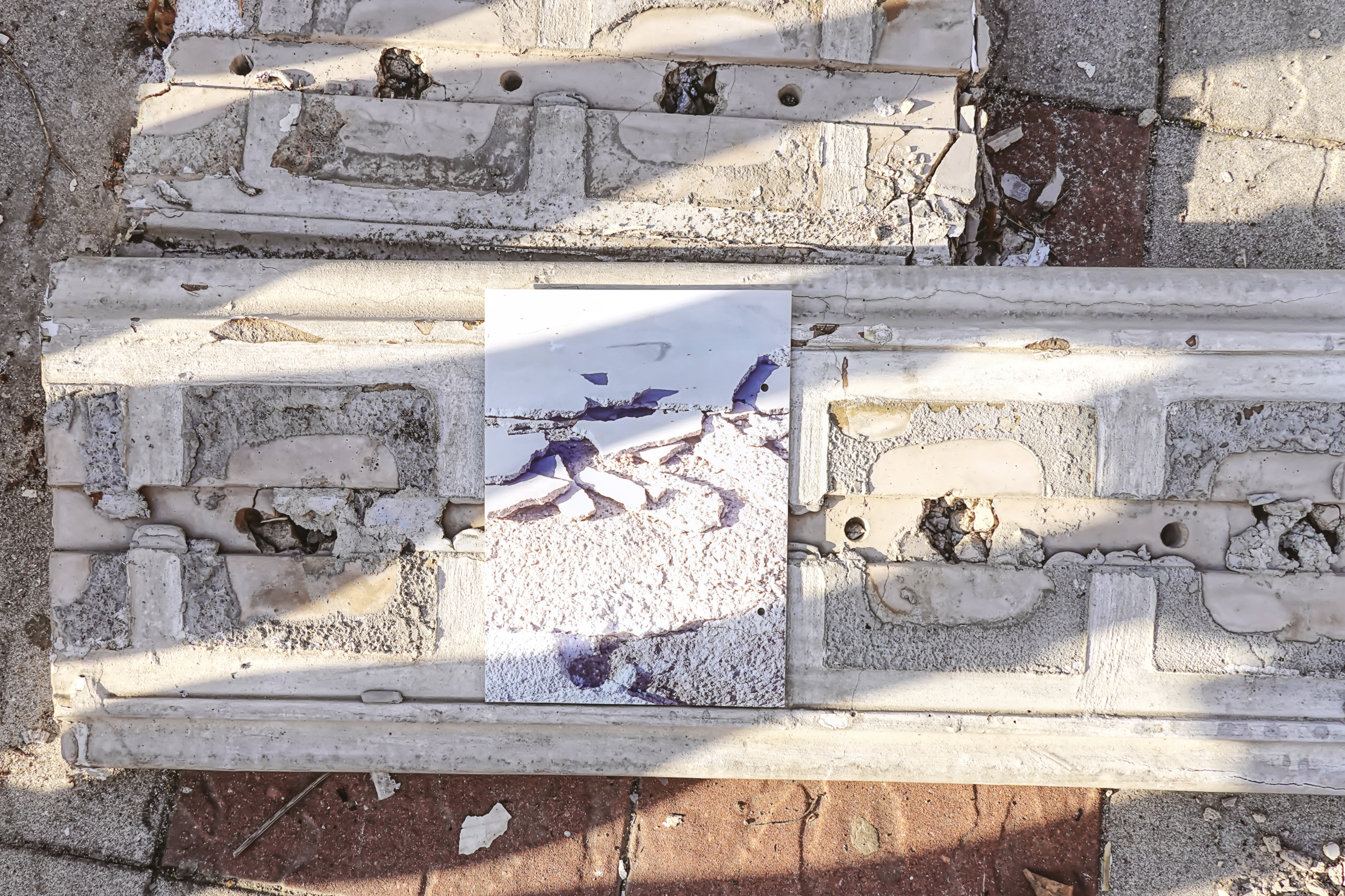
# Scene 3
>41.99861634715371, 21.432071820598438
Newlyweds stand on each side of a railing that foregrounds where the floor is cut abruptly, continuing a few decimetres lower. One stands on the higher part of the rail. The other is on the lower step, lightly kneeling and looking as if hanging off the balcony. The photographer circulates and tries to find a moment where the two look effortless. It feels like watching a reenactment of a scene from "Romeo and Juliet".
A thought slips into my mind: Their love was deadly.
The wedding planner moves around with a thick schedule, like a stage director, while the two perform their life. I observe how their bodies do not touch the rail. When something had contact with the railing, parts of the material fell off. The cracks are far too deep. I doubt whether to photograph the scene. It is entrailing to see how the theatre scene extends outside, in the set-like surroundings where the performers must be aware of their movements. How much weight can you put on the railing? Can you lean forward with your body?
I decide to respect their privacy. But as two other couples approach, I feel the need to ask the planner if this is indeed a popular setting for such images. Quickly I get a confirmation. The planner tells me how the new buildings make the images as if they are someplace else while shaking off the little plaster that has fallen on the bridal dress. Happily, they are both white. <
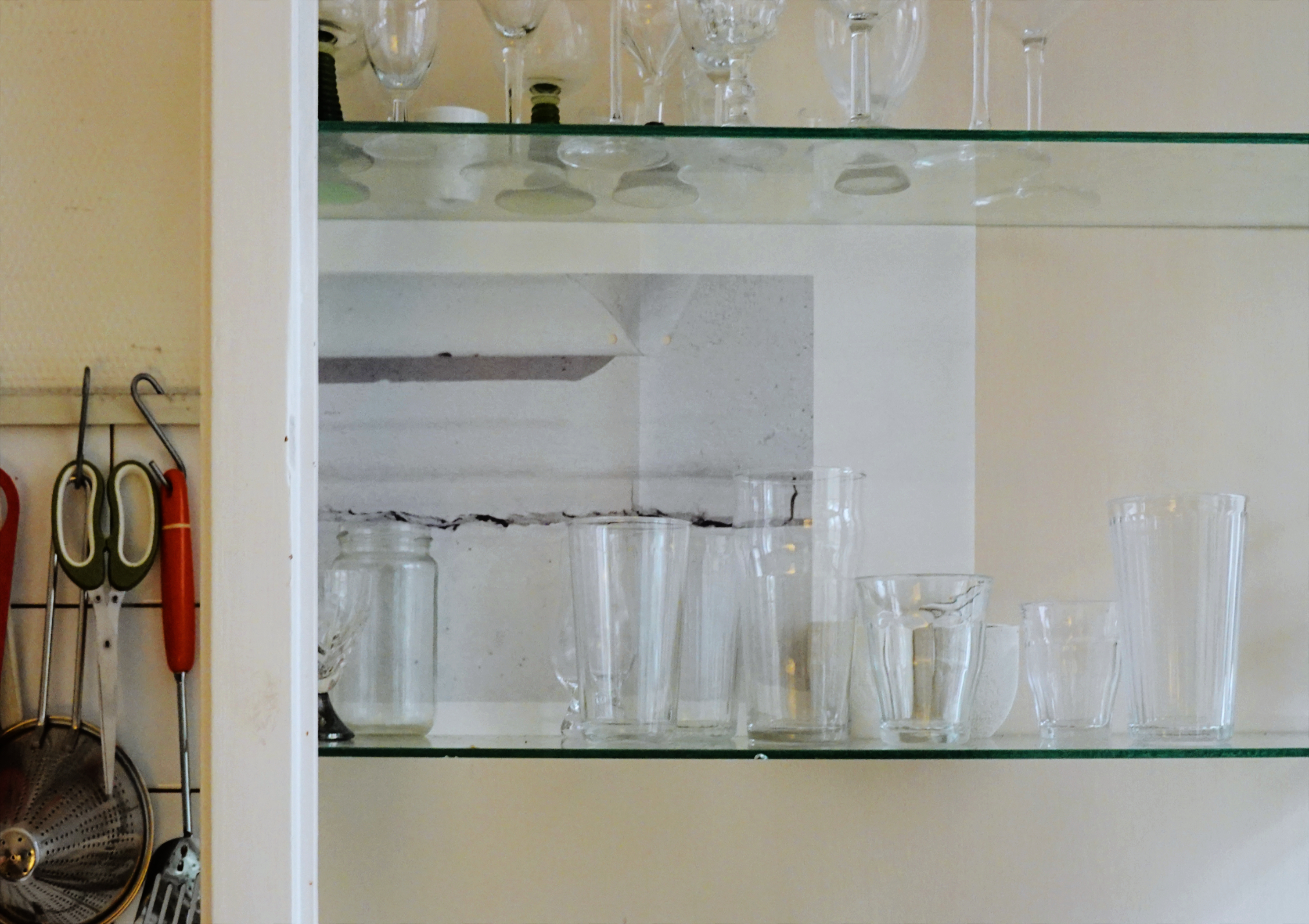
From Façade_Override_Façade: Domestic Series, a series of exhibitions in private houses in Amsterdam, 2021 organised in collaboration with Marjoca de Greef
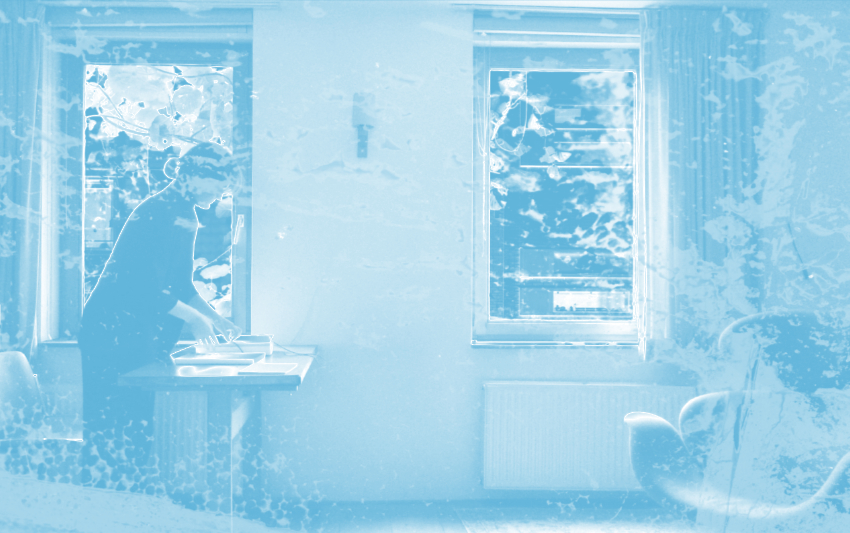

My grandmother has a strong memory of the old theatre building. The one that was damaged during the devastating earthquake in 1963. Although the damages to the building were not irreparable, the building was torn down. I show her two images, one from the building she often visited and another from the new building that tries to show itself as a replica. I am wondering to what extent they are identical to one another. Not the images. The two buildings.
She points out the mirrored entrance. In her youth, she entered the building too many times so she is confident that the orientation of the entry has changed.
She pauses.
She tilts her head slightly. Her hand lays on the table surface. The index finger slowly stretches out, tapping onto the wooden surface in a thinking pattern. Then she gently closes her eyes, entering her retinal memory.
She tells me that the building looks bigger and somewhat different. I sense a slight insecurity in her voice. Many years have passed since she last saw the theatre building, so she wonders if her memory is correct. Or has she, in time, displaced her recollections? She clears her throat with a sip of water. Pauses. She looks at the images with a questioning gaze and asks: “Do you think they are allowed to say that this is an act of rebuilding… then it should have been an exact copy. Not approximately, not close to, but identical.”
Talking about it stirred something in her, so she says: “It is a predictable selection of buildings, a few that might cause an emotional trigger. Something that was lost is being re-introduced in times when a large part of the centre is unrecognisable. Mediation of a false reality of the past-present. As if making a fictive novel, the writer needs to introduce elements that can be traced in the experienced world.”
I think of a passage I read somewhere about Kinkaku-ji, the Gold Pavilion Temple in Kyoto, which in the past has been destroyed by fire and restored several times. The latest fire in 1950 scalded the temple's timber structure. Albeit the faithful reconstruction based on detailed analyses done in 1908, many considered that the damage compromised the material authenticity of the temple. However, in Japan, preservation focuses much more on the intention of the building, the enduring elements that make the building, and the techniques and tools used during the building process. Attention and carefulness to detail during strenuous restorations, at times, call for the reproduction of original tools that can perform ancient craftsmanship and repair techniques.
Building draws its meaning from dwelling
— unused muscles atrophy.
Part of building is to exercise material capacities.
No matter is permanent. Everything is exposed to exhaustion.
Plaster is applied to both bodies and buildings, but we prefer to take care more of one than the other.
We place a plaster cast on broken limbs to maintain a stable posture while healing.
I put a book about architectural plaster casts back on the shelf. I see the wood slightly bending from the weight.
Taking care of and maintaining is part of the dwelling.
But how to maintain something shared between plural 'we' while desynchronizing thought processes start taking place?
Collectives part easily.
Can we preserve something which we have failed to protect?
What happens when a building reconstruction is initiated five decades after an orderly tear-down? Following the earthquake, the theatre community voiced their willingness to save the building and repair the damages. But then it was decided that the building had to go.
Can one reconstruct the readiness of a group of people?
How do we make tools that can reproduce such willingness?
And who makes up the ‘we’? Do I have permission to speak of ‘you and me’ as a ‘we’?
>recollection<
I push my body into a full double-decker bus. I go to the upper floor and sit on the first empty seat. After a few seconds, I feel a body filling up the space next to me. We just crossed one of the few bridges from where the massive change in the city centre is visible. The sun has set, and it is the first time that I see the newly erected buildings illuminated by colourful spotlights. Vivid colours paint the ghostly white facades.
I hear a female voice coming from my left.
At first, I thought the woman was talking to me, but I discover that she is on the phone with someone. The space between us is almost non-existent, so I cannot escape but overhear her conversation.
In an excited and high-pitched voice, she gives someone her location and then darts praising the city centre, the wonderful lightning, the European appeal, the fountains…Between her words of praise, a sentence slips in which she accuses the citizens who are against the reconstruction, saying: “They have lost touch with reality!”
My eyes must have gone wide upon hearing that because while angling her eyes towards me, in a slightly hushed tone she says: “The girl sitting next to me is probably one of those.” I confirm her statement with a slight smile. Her phone conversation is over. There is a pause. A few silent moments before a storm of questions washes over me. Why do I disagree with the recent remodelling? What is so bad about having new monuments, buildings and fountains? She also brings up the identity of the city and how we are now free from the past.
>Interlude
The verb freeing appears in all the discussions regarding public space.
To free it, to occupy
To occupy in order to free it
To free it so that it can be occupied
The act of building is grounded in occupancy.
To inhabit is to occupy. Bodies seize the space needed and position themselves in it. Dwelling puts empty spaces on hold.
Taking space away is associated with a site invaded by someone, something that does not allow others to breathe the same place.
Breathing takes up space.
Exhaling.
Circulating.
Other times, occupancy gains a different meaning. It is a subversive communal act that urges to restructure established power. Observing the gesture, we can read what type of readiness is attached to an act of occupancy.
Making a clear distinction between
empty spaces
open spaces
free spaces
public spaces
is necessary. At first glance, they might be similar, but when you think about it, they are not synonymous. Understanding their potential and limits can be relevant when discussing the possibilities of new publicness.<
Usually, I do not enjoy talking while commuting through the city. This time, I found the ride animating. The people with whom I communicate daily share similar concerns regarding the city. I have forgotten that some admire the changes. So I continue discussing. In the beginning, I try to listen more. Her questions are intriguing. This voice is new to me so I attempt to understand her as much as possible. The dividing line between our opinions makes the conversation very engaging. I become aware that the woman wants to convince me of how the changes benefit the citizens. She shows me photos of her children and enthusiastically tells me how much fun they have while playing around the monuments. I see them posing in front of the newly added elements in the city. They do look happy, I agree. Their smiles contrast my interrogative glare whenever I pass by the exact location, collecting records of ongoing material processes. Noting more and more polystyrene becoming visible from behind the thin layer of plaster.
All their struck poses.
All my heightened heart palpitations ,
Hesitantly, I ask her what of the buildings whose façades got transformed without permission of the architects and now rest under new layers of plaster and polystyrene. She instantly responds that it is very normal for a façade to be repaired after so many decades, and adds that the architects do not own the buildings. As an example, she brings out the government building, a state-owned property. It is also one of the buildings that went through a complete transformation, even though everyone considered that building to be architectural heritage. I ask her how she defines repair, but she overrides my question and continues telling me how the state owns the government building and therefore the government can change the structures if they wish to do so.
There is a lot to process. Too many things were thrown at me. The air in the bus is quite dry from the air conditioning so I take a sip of water.
We go back and forth, trying to understand our different understanding of repair, of authorship and ownership, especially the ownership in relation to the public space.
The muscles around my eyes gather in a questioning gaze, as the woman says that we have selected the government to act in our name. Her reply echoes loudly in my head, because I try to grasp if she meant the government in general, or the government in question. The second was correct. Another wave of confusion - I never voted for this government.
But I also realised that suddenly she referred to us as a “we” while moments ago she referred to me as “those others”.
I want to continue the conversation, but I need to get out on the upcoming stop. I greet the woman and leave the bus with confusion in my head.
>Erasure is not a stranger to Skopje’s architectural landscape. Traces of distinct presences exist as markers for diverse narratives that follow each other, supporting, overwritting, fragmenting, continuing, and ceasing. Trauma is present in those who survived the earthquake. The disaster obliterated parts of the built structures inherited throughout time, particularly the buildings from the early and mid-twenties. We perceive buildings as bodies, as extensions of ourselves. They become support structures for our encounters and experiences. When witnessing a building shattering in an instance, one feels the fractures as their own, confronting their fragility. I spent my childhood days and teenage years in Skopje, so I am wistful for the warmth of the concrete who oftentimes I kissed to see if it was alright. It is not the physical warmth but its sincerity that moved me: I knew the bruise would hurt when falling on bare concrete.
Should I detach myself from my memories so that I can chew over the current image?
Voices echo. Louder. The echo echoes.
Dissimilar pitches fill up the distance between antithetical surfaces.
Should I detach myself from my memories so that I can chew over the current image?
Voices echo. Louder. The echo echoes.
Dissimilar pitches fill up the distance between antithetical surfaces.
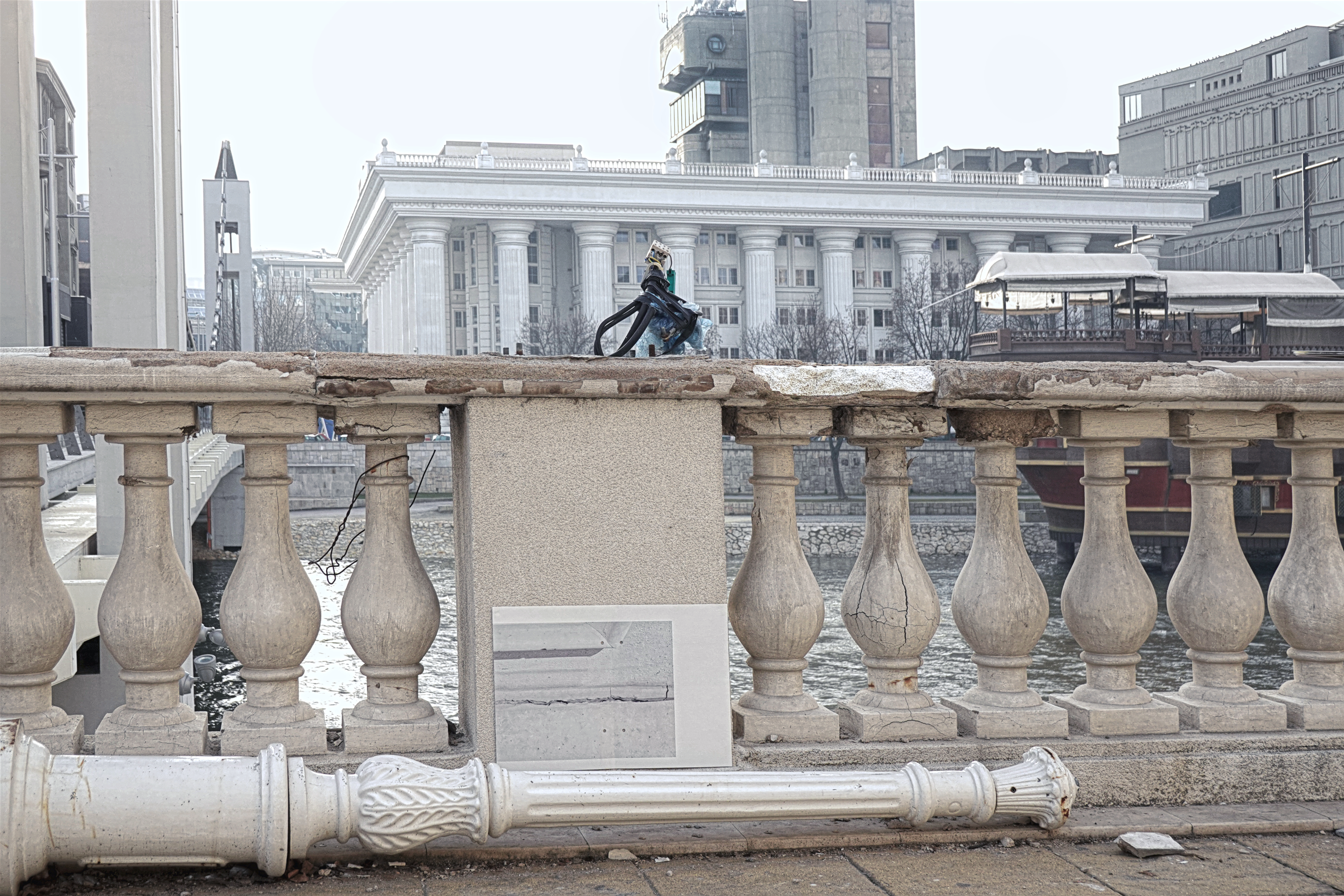
Part of the installation Façade_Override_Façade, 2022, presented in Arti et Amicitiae, in the context of the exhibition:
(◦)In the pause of a gesture there might be an echo #3
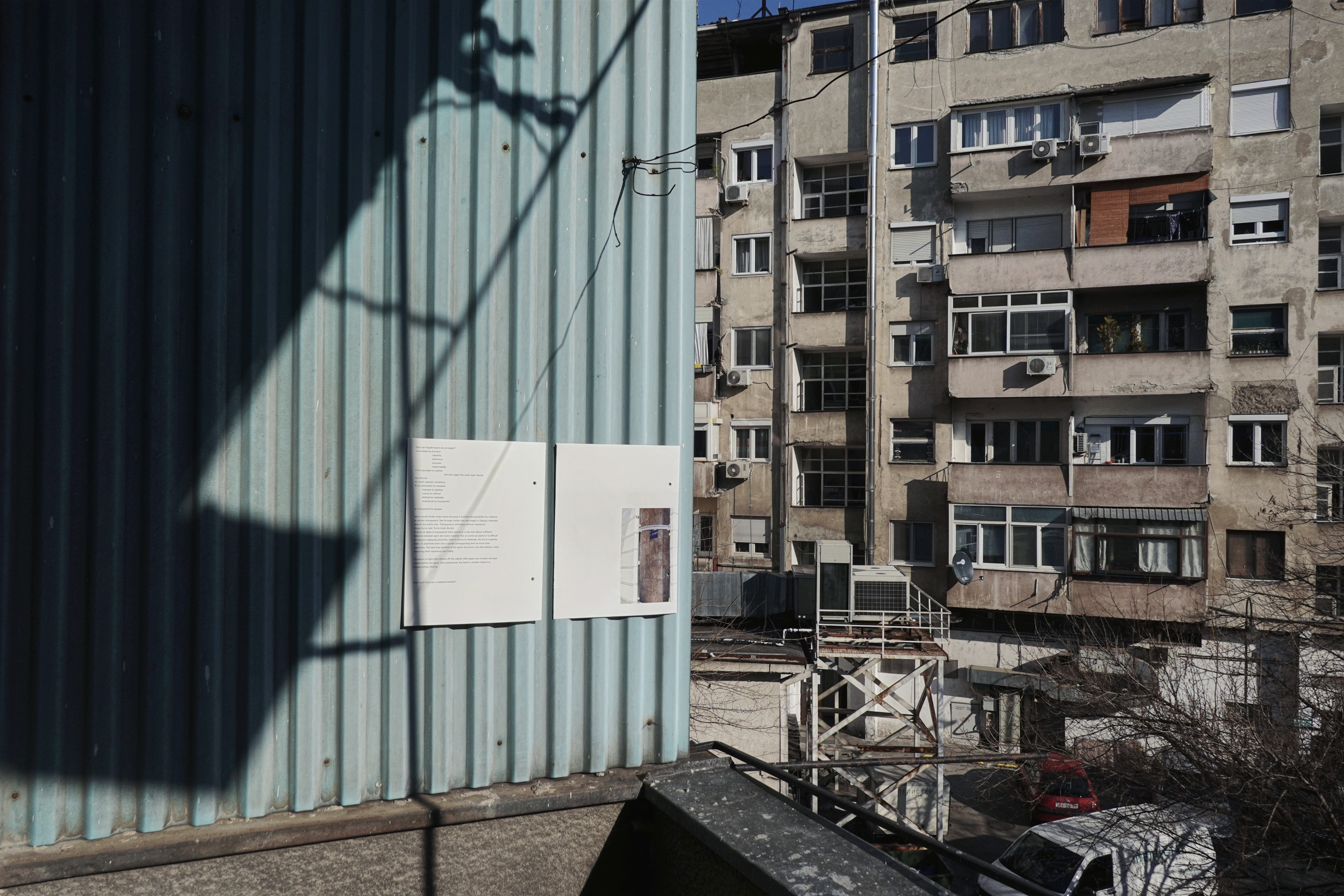
A landscape is a compressed time. Traces of use are superimposed. Existing traces condition those to come, and those that follow use the present as markers for their movements. City planning is a complex process. A city runs like an organism or a machine. Tools and metabolisms have something in common: bolts become loose, the oil that prevents friction wears off, and cells clash with one another. A high fever indicates the presence of an infection that triggered the immune system. The high temperature of my body is my immune system's attempt to create an environment where the bacteria can’t survive. Simultaneously it stores information of every microbe it has ever defeated. That is how a body builds immunity. We learn about an ongoing situation when things confront each other. Particularly in polarized societies, where contrasting views persist as antagonistic fights. The physical public space is an embodiment of ongoing processes.
How do precise lines coexist with hurriedly attached matter?
When responding to carelessly applied matter, each movement should be carefully performed. We already move in contested spaces conditioned by a debt "we" did not create.
Inherited structures of embodied animosity.
How much weight can these columns carry?
Layers of polystyrene slowly detaching. Crumbling.
Crisis calls for reconstructing closed activities. After the halt, where do we begin?
Can the friction be a point from which a recognition occurs?
A space shaped by ‘what no longer is’ and what is ‘yet to come’.
A piece of plaster nearly hit me when walking between the new buildings. I keep it on my desk as a souvenir of the day I survived Skopje 2014. The materials used for the buildings are exhausting at a fast speed.
How do precise lines coexist with hurriedly attached matter?
When responding to carelessly applied matter, each movement should be carefully performed. We already move in contested spaces conditioned by a debt "we" did not create.
Inherited structures of embodied animosity.
How much weight can these columns carry?
Layers of polystyrene slowly detaching. Crumbling.
Crisis calls for reconstructing closed activities. After the halt, where do we begin?
Can the friction be a point from which a recognition occurs?
A space shaped by ‘what no longer is’ and what is ‘yet to come’.
A piece of plaster nearly hit me when walking between the new buildings. I keep it on my desk as a souvenir of the day I survived Skopje 2014. The materials used for the buildings are exhausting at a fast speed.

All the images have been produced in the context of the project in the period between 2020 and 2022.
The long-term artistic research project Façade_Override_Façade was part of the Suns and Stars program of 2021-2023, an overarching program for artistic practices that develop through open-ended research in a context of collaboration, initiated by Marjoca de Greef and Anastasija Pandilovska. Other participating artists were Sarah van Lamsweerde and Aram Lee and Richtje Reinsma.
Façade_Override_Façade departed from research that Pandilovska developed within the context of LAPS, Research Institute for Art and Public Space in Amsterdam, The Netherlands where she investigated new understandings of publicness as practice.
Made possible with the generous support of Mondriaan Fonds and Prins Bernhard Cultuurfonds -Tijl Fonds.

